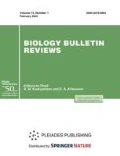Abstract
The structural complexity of communities of living organisms can be assessed in various ways, including diversity indices. For these purposes, the Shannon index (H) was used in the present study. Based on the scarce available published data and our own data, the rates of changes in the number of species and complexity of the community structure of aquatic organisms were determined with reference to macrobenthos communities. The considered changes were described by equations of specific functions that were mathematically analyzed. It was suggested that, in a temperate climate and the absence of strong contamination or eutrophication of water bodies, 12–14 years on average are required for the formation of a complex structure (3–4 bits) of benthic animals under favorable conditions. The complex structure of communities formed in polluted waters remains rather constant. Longer studies (at least 20–30 years) than those used in the present work are necessary to verify and refine the above assumptions
Similar content being viewed by others
References
Alimov, A.F., Elementy teorii funktsionirovaniya vodnykh ekosistem (Elements of the Theory of Functions of Aquatic Ecosystems), St. Petersburg: Nauka, 2000.
Bakanov, A.I., Use of zoobenthos for monitoring of freshwater reservoirs, Biol. Vnutr. Vod, 2000, no. 1, pp. 68–82.
Balushkina, E.V., Evaluation of ecosystems and water quality in the Neva River estuary using zoobenthos, in Ekosistema estuariya reki Nevy: kolichestvennoe raznoobrazie i ekologicheskie problemy (Ecosystem of the Neva River Estuary: Quantitative Diversity and Ecological Problems), Moscow: KMK, 2008, pp. 411–426.
Belyakov, V.P., Long-term dynamics of zoobenthos, in Mnogoletnie izmeneniya biologicheskikh soobshchestv mezotrofnogo ozera v usloviyakh klimaticheskikh fluktuatsii i evtrofirovaniya (Long-Term Changes of Biological Communities of Mesotrophic Lake Affected by Climate Changes and Eutrophication), St. Petersburg: Inst. Ozeroved., Ross. Akad. Nauk, 2008, pp. 167–184.
Geografiya i monitoring bioraznoobraziya (Geography and Monitoring of Biological Diversity), Kasimov, N.S., Ed., Moscow: Mosk. Gos. Univ., 2002.
Ignat’eva, N.V. and Barbashova, M.A., Evaluation of the quality of bottom sediments in the Lake Ladoga according to chemical and biological parameters, Trudy IV mezhdunarodnogo simpoziuma po Ladozhskomu ozeru “Okhrana i ratsional’noe ispol’zovanie vodnykh resursov Ladozhskogo ozera i drugikh bol’shikh ozer,” Velikii Novgorod, 2–6 sentyabrya 2002 g. (Proc. IV Int. Symp. on Lake Ladoga “Protection and Rational Use of Water Resources of the Lake Ladoga and Other Large Lakes,” Veliky Novgorod, September 2–6, 2002), St. Petersburg: Inst. Ozeroved., Ross. Akad. Nauk, 2003, pp. 91–96.
Margalef, R., Our Biosphere, Oldendorf: Ecology Inst., 1997.
Odum, E.P., Fundamentals of Ecology, Philadelphia: Saunders, 1953.
Protasov, A.A., Bioraznoobrazie i ego otsenka. Kontseptual’naya diversikologiya (Biological Diversity and Its Evaluation. Conceptual Diversification), Kyiv: Inst. Geogr., Nats. Akad. Nauk Ukr., 2002.
Puzachenko, Yu.G., Bezdelova, A.P., Vinogradova, T.A., and Aleshchenko, G.M., The assessment of biological diversity on the basis of occurrence, Russ. J. Ecol., 1999, vol. 30, no. 5, pp. 291–300.
Raspopov, I.M., Andronikova, I.N., Slepukhina, E.V., et al., Pribrezhno-vodnye ekotony bol’shikh ozer (Coastal-Aquatic Ecotones of the Large Lakes), Raspopov, I.M., Ed., St. Petersburg: Inst. Ozeroved., Ross. Akad. Nauk, 1998.
Raspopov, I.M., Andronikova, I.N., Barbashova, M.A., et al., Long-term monitoring of biota development in ecosystem destroyed by wastes from pulp and paper plant (Shchuchii Bay, Lake Ladoga), Trudy IV mezhdunarodnogo simpoziuma po Ladozhskomu ozeru “Okhrana i ratsional’noe ispol’zovanie vodnykh resursov Ladozhskogo ozera i drugikh bol’shikh ozer,” Velikii Novgorod, 2–6 sentyabrya 2002 g. (Proc. IV Int. Symp. on Lake Ladoga “Protection and Rational Use of Water Resources of the Lake Ladoga and Other Large Lakes,” Veliky Novgorod, September 2–6, 2002), St. Petersburg: Inst. Ozeroved., Ross. Akad. Nauk, 2003, pp. 338–342.
Author information
Authors and Affiliations
Corresponding author
Additional information
Original Russian Text © A.F. Alimov, 2017, published in Uspekhi Sovremennoi Biologii, 2017, Vol. 137, No. 4, pp. 323–327.
Rights and permissions
About this article
Cite this article
Alimov, A.F. Long-Term Dynamics of Biological Diversity in Water Basins. Biol Bull Rev 8, 67–71 (2018). https://doi.org/10.1134/S2079086418020020
Received:
Published:
Issue Date:
DOI: https://doi.org/10.1134/S2079086418020020




